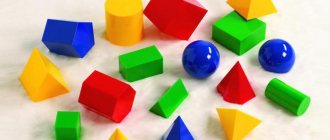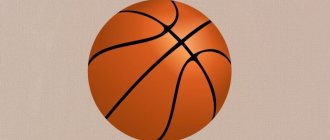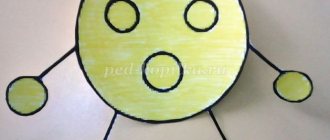Summary of GCD for FEMP. Senior, preparatory group. Generalization of knowledge about geometric shapes
Summary of the GCD lesson “Cognition.
Formation of elementary mathematical concepts.” Topic: “Generalization of knowledge about geometric figures” Author: Elena Aleksandrovna Ustinova, teacher of the pre-school preparation group of the branch of MBOU Sosnovskaya Secondary School No. 1 in the village of Semikino, Sosnovsky district, Tambov region. Description of the material: I offer you a summary of a lesson on the formation of elementary mathematical concepts on the topic “Generalization of knowledge about geometric figures.” It will be useful for teachers working with older preschoolers. The lesson notes are aimed at summarizing in a playful way the older preschooler’s existing knowledge about geometric shapes and their properties. Educational field: cognition. Type of direct educational activity: the formation of elementary mathematical concepts. Integration of educational areas: “Cognition”, “Communication”, “Socialization”, “Health”, “Reading fiction”, “Artistic creativity”. Audience: the lesson notes are designed for teachers working with older preschoolers, as well as for parents of older preschoolers and children aged 5-7 years. Goal: generalization of previously acquired knowledge about geometric shapes and their properties. Objectives: • teach the ability to find geometric shapes in the surrounding space; visual recognition and transformation of geometric figures, recreating them from representation and description. • promote the development of spatial concepts, figurative and logical thinking, creative imagination; • cultivate children's interest in geometry and skills of working in groups. Methodological techniques: Verbal: explanation, reminder, clarification, assessment of children’s activities, instructions, conversation, artistic expression, questions. Visual: showing pictures with geometric shapes. Practical: coloring drawings, highlighting and counting figures, constructing objects according to pre-prepared sketches and templates, working with signal cards, physics. just a minute, finger gymnastics. Gaming: creating a gaming situation. Problematic: help Masha and the Bear put together a picture, get home. Integration of areas: cognition: (improve children’s counting skills, practice counting within 10, learn to construct objects from geometric shapes, learn to recognize geometric shapes in surrounding objects); health: consolidate the acquired knowledge with children through a set of games, dynamic breaks, and practical exercises; help improve the overall performance of children, relieve mental stress, and easily switch from one type of activity to another; socialization: encourage children to engage in a joint play situation with adults, develop emotional responsiveness and goodwill; communication: master basic skills of speech etiquette; fiction: reading poems and riddles about geometric shapes; artistic creativity: drawing kittens using geometric shapes, coloring books with colored pencils. Equipment: • for the teacher – computer, projector, multimedia board, pictures of geometric shapes, visual aids with shapes, pictures with fairy-tale characters;
• for children – coloring books, colored pencils, a set of geometric shapes-templates, cards with numbers. Direct educational activities.
1. Org. moment. — Guys, the fairy-tale heroes Masha and the Bear came to our lesson today. They did not come empty-handed, but prepared tasks and questions for us to which we must find the correct answers. If we answer correctly, we will earn prizes from our heroes. 1) Riddle: My little brother, Seryozha, Mathematician and draftsman - On Baba Shura’s table He draws all sorts of... (figures) - Our lesson is devoted to geometric figures. Let's remember what geometric figures we know (the teacher shows drawings of the figures and reads a poem).
He's been a friend of mine for a long time, Every angle in him is straight, All four sides are the same length, I'm glad to introduce myself to you, but my name is... (square!)
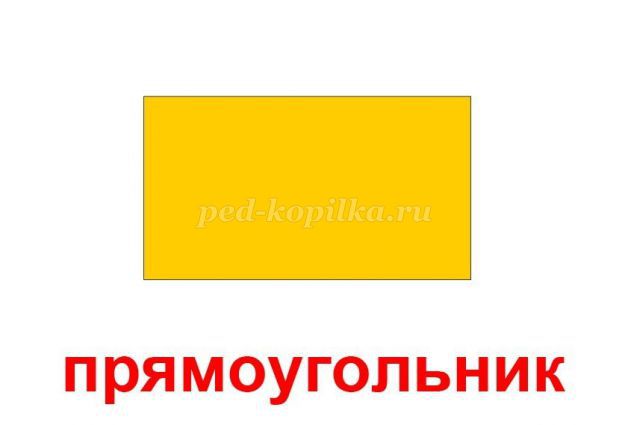
We stretched out the square and presented it to the eye, Who did it look like or something very similar? Not a brick, not a triangle - Became a square... (rectangle).
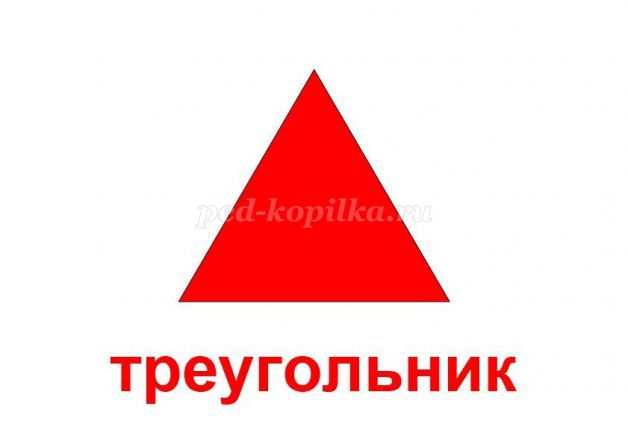
Three peaks are visible here, Three corners, three sides - Well, perhaps that’s enough! - What do you see? - …(triangle)
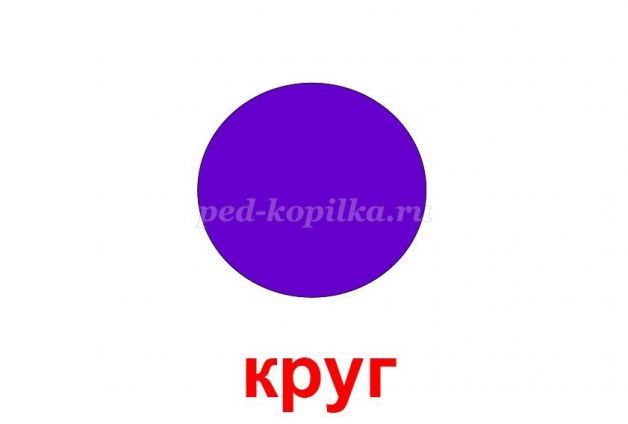
The wheel rolled, After all, it resembles, Like a visual nature, Only a round figure. Did you guess it, dear friend? Well, of course, this is... (circle).
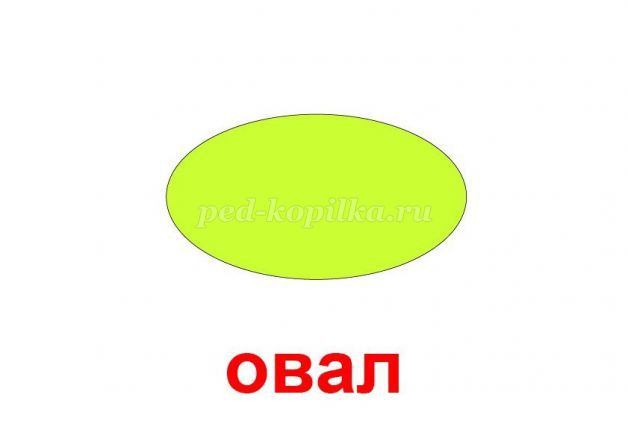
A watermelon slice is a semicircle, half a circle, part of it, a piece. Knowing about forms is very important, friend. No wonder it is among these lines! If I took a circle, squeezed it a little on both sides, answer children together - It would turn out ... (oval)
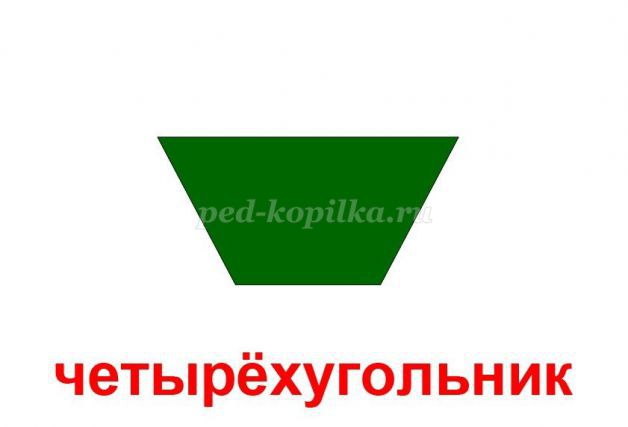
They filed the triangle and got a figure: Two obtuse angles inside and two acute ones - look. Not a square, not a triangle, but similar to a polygon (trapezoid).
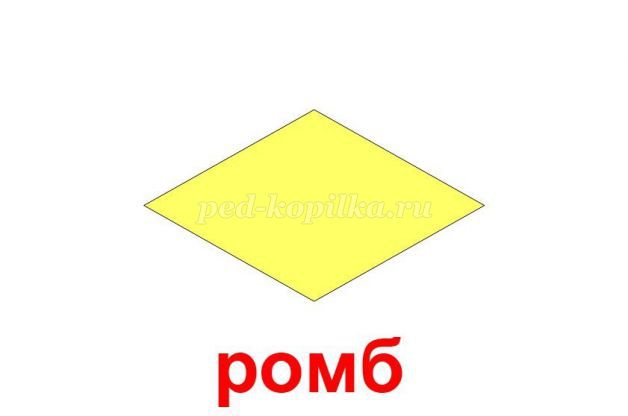
A slightly flattened square Invites to identify: An acute angle and an obtuse one Eternally linked by fate. Have you guessed what it's all about? What should we call the figure? (rhombus).
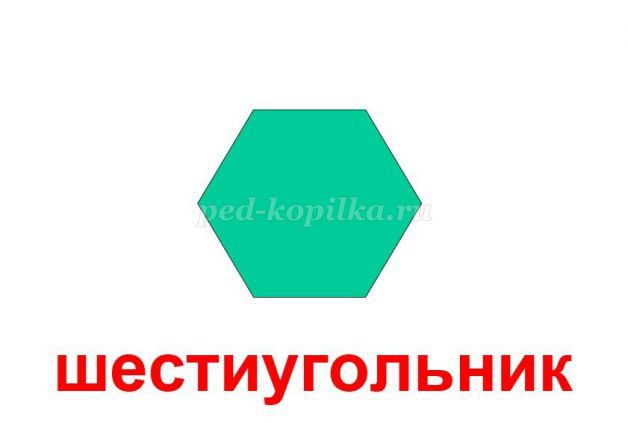
Look at the six obtuse angles inside the figure and imagine that from the square you got his brother. There are too many angles here, are you ready to name it? (hexagon)
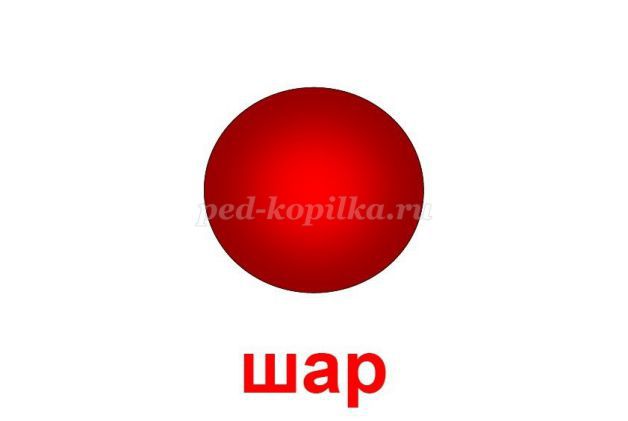
We get down to business again, We study the body again: Maybe it can become a ball And fly a little. Very round, not oval. Did you guess it? This is... (ball).

How can we avoid turning it? There are exactly six equal faces. We can play lotto with him, We’ll just be careful: He’s neither affectionate nor rude Because it’s... (cube).
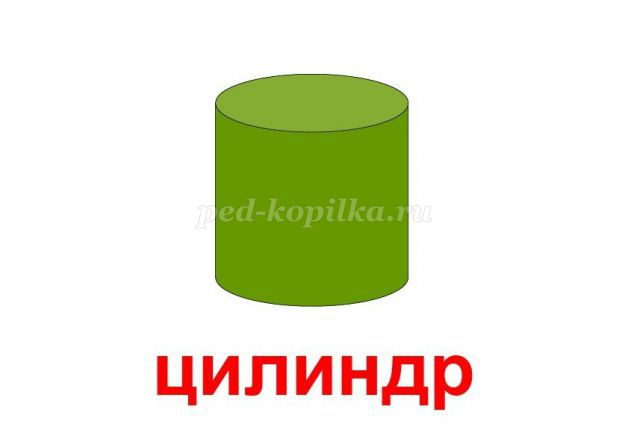
Cover on top, bottom on bottom. Two circles were connected and a figure was obtained. What should we call the body? We need to quickly guess (cylinder).
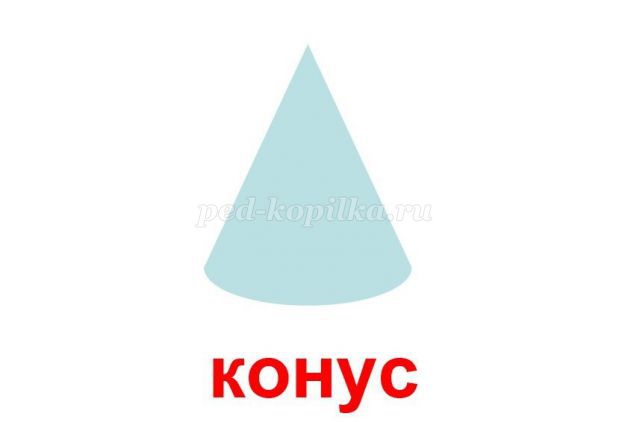
Here is a cap on the head - This is a clown on the grass. But the cap is not a pyramid. This, brothers, is immediately obvious: The circle is at the base of the cap. What should he be called then? (cone).
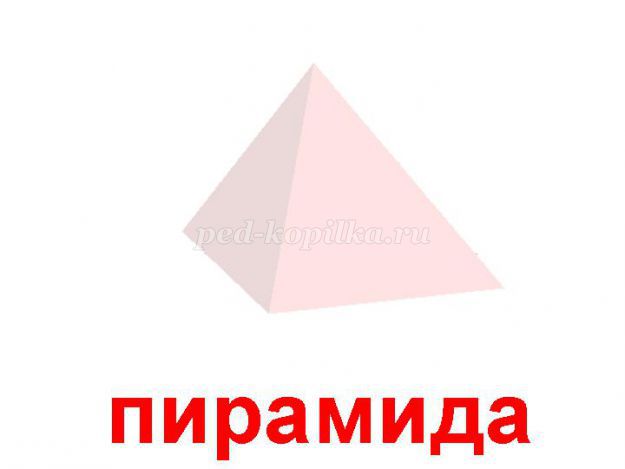
The Egyptians put them together and crafted them so cleverly that they stand for centuries. Guess for yourself, children, what kind of bodies are these, Where is the top visible to everyone? Did you guess it? Because of the view, Everyone knows... (pyramid).
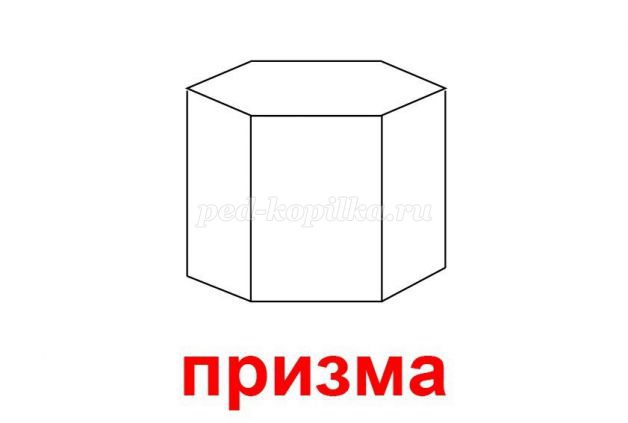
This seems to be a bucket, but the bottom is completely different: Not a circle, but a triangle, or even a hexagon. The body is very capricious, Because it is... (prism). 2) Logical tasks:
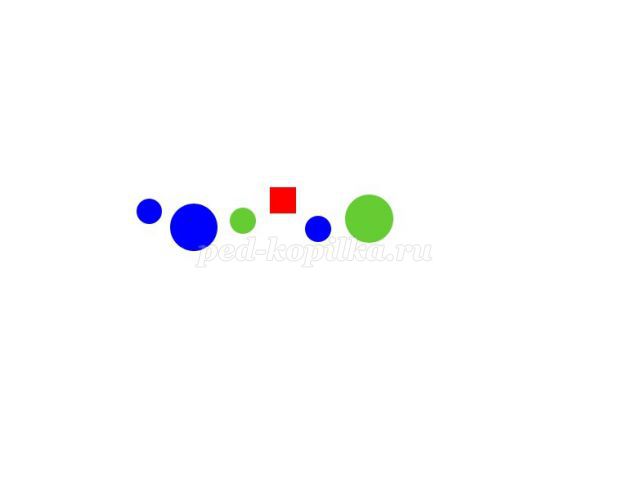
Name the figures. Which one is the odd one out? Why? Name the color of each shape.
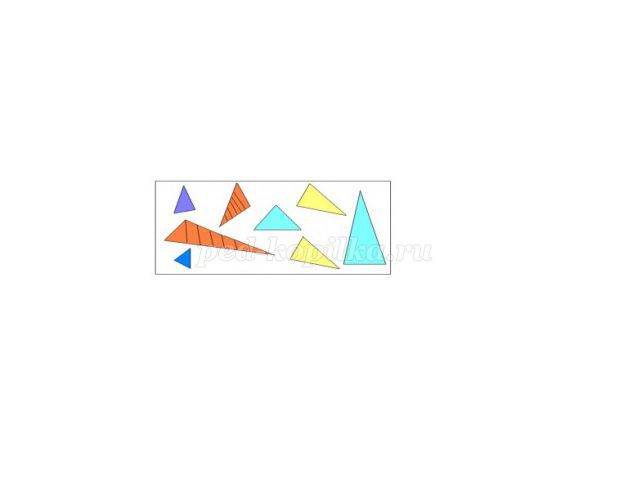
- What do these figures have in common? What is the difference? Find two identical figures. What signs of triangles do you know?
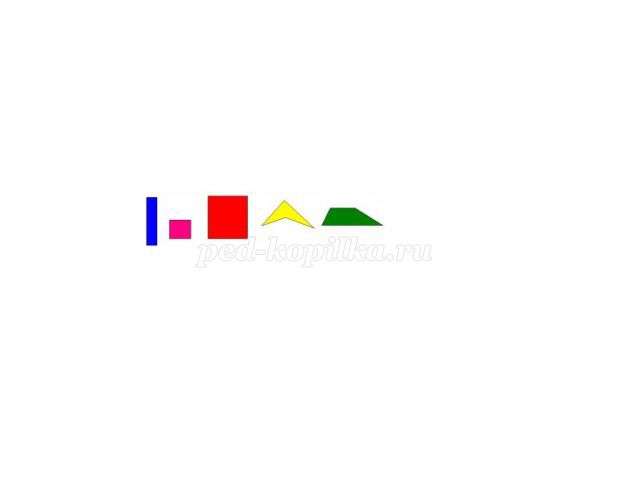
-What are the names of the figures? What do they have in common? Which figure is the odd one out and why? Which of the figures is the largest? Which one is the smallest? 2. Physical education (performed according to the drawing on the board)
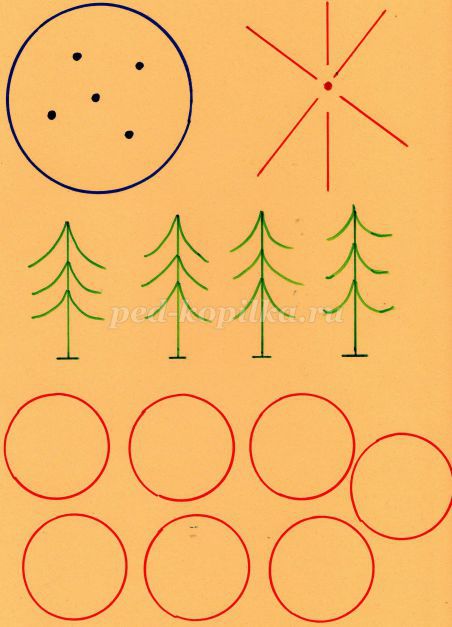
How many dots are there in this circle? Let's raise our hands so many times. How many sticks to the point, How many will we stand on our tiptoes. There are so many green Christmas trees, so many bends we can make. How many circles we have here, How many jumps we will make. 3. Game “Fold the picture”. — Masha and the Bear offer to put together pictures of geometric shapes using ready-made cards. To do this, we will split into two groups. Each group will create their own picture. But first, let's take a closer look at the cards. Name the geometric shapes from which the pictures are composed. How many figures are there in total? What color are the figures? First you need to put the picture together, looking at the card, and then from memory.
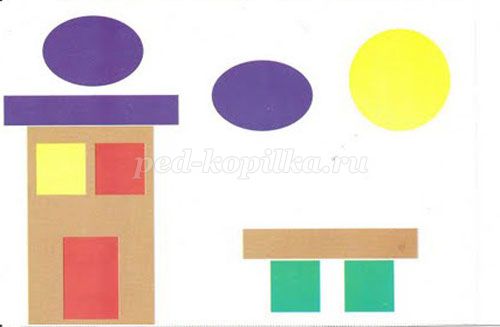
4. Riddles from Masha and the Bear. Look at the figure and draw three corners in the album. Connect the three sides together. The result was not a square, but a beautiful... (triangle). I am a figure - no matter where, Always very even, All angles in me are equal And four sides. Kubik is my beloved brother, Because I…. (square). It looks like an egg or your face. This is the circle - It has a very strange appearance: The circle has become flattened. It turned out suddenly... (oval). Like a plate, like a wreath, Like a cheerful bun, Like wheels, like rings, Like a pie from a warm oven! (circle) A slightly flattened square Invites to identify: An acute angle and an obtuse one Eternally connected by fate. Have you guessed what it's all about? What should we call the figure? (rhombus). This figure is the brother of our square, but only two sides are equal, and the angles are all the same... (rectangle)
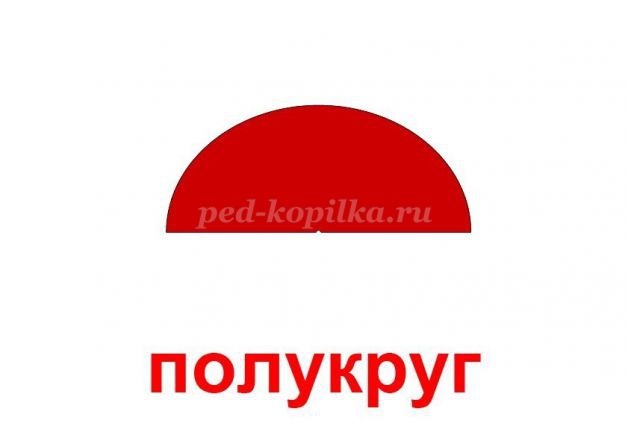
This is a month in the clouds and half an apple in your hands. If you suddenly break the circle, You will get... (semicircle). 5. Finger game “Kittens” (author: Pakhomova E.V.) (We fold our palms, press our fingers together. Elbows rest on the table) Our cat has ten kittens, (We shake our hands without separating them). Now all the kittens are standing in pairs: Two fat, two dexterous, Two long, two cunning, Two small and the most beautiful. (Tap the corresponding fingers against each other from the big to the little finger).
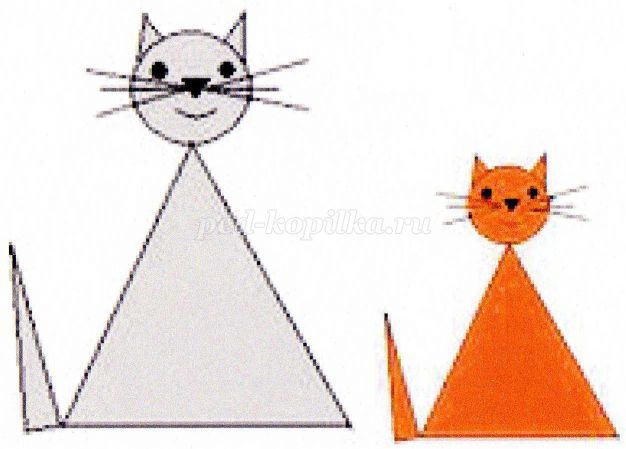
- Compare the kittens. How are they similar and how are they different? - Count how many triangles there are in the picture? - How many circles? — Try to draw your kittens. You can use other shapes. 6. Practical work “Geometric coloring”.
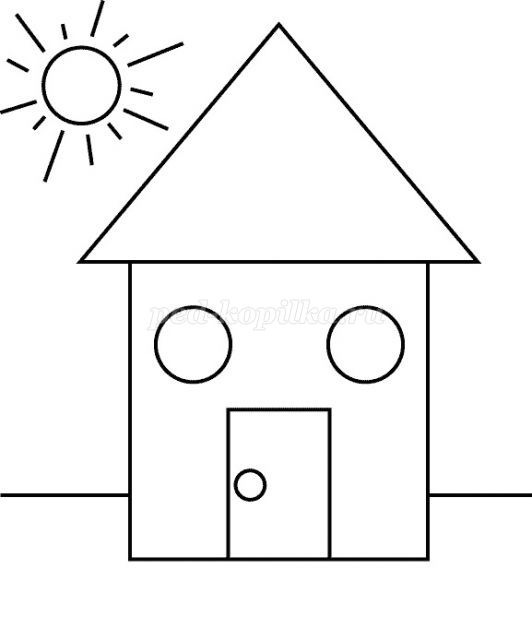
- Masha and the Bear ask you to color the picture with colored pencils and count how many geometric shapes you have found. — How many circles? — How many triangles? — How many squares? — How many rectangles? 7. Test of knowledge. — Children, Masha and the Bear really liked how you worked in class today. They have prepared a surprise for you. And now they need to go back. But our heroes forgot the way. Let's help them get home. And a map on which objects are depicted as geometric shapes will help us with this. - How do we get across the river? (on the bridge or on the boat) - What geometric shapes did we see? (semicircle, trapezoid) - What figure is the path in the forest depicted in? (curved line) - On the way we came across a lake, what figure is it depicted with? (oval) - Does the path around the lake lead past a flower meadow? What figure is she depicted in? (around) - So we came to the Bear’s house. What figure represents the fence near the house? (broken line) - What figures is the Bear’s house made of? (rectangles, triangle, circles). Well done guys, you did a great job!
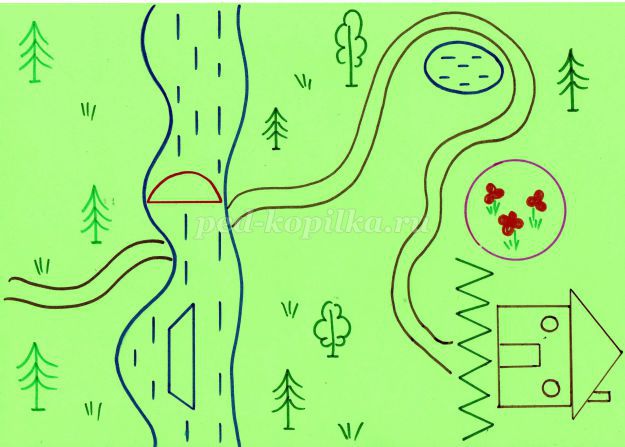
8. Summary of the lesson, reflection. - Our lesson has come to an end. Let's remember what we did today? What was difficult for you? What did you like most? What didn't you like? - Evaluate yourself. If you enjoyed the activity and are happy with your work, raise the green circle. If you didn’t like it and you’re not happy with something, raise the yellow circle. — Masha and the Bear are grateful to you for your help. They have prepared a sweet prize for you (candy, fruit). Summary of the article. I hope that the lesson notes I have proposed on the topic “Generalization of knowledge about geometric figures” will be useful to teachers working with older preschoolers and will be interesting to children. The lesson helps to develop children's interest in geometry, the development of spatial concepts, figurative and logical thinking, and creative imagination.
We recommend watching:
GCD summary for FEMP in the preparatory group “Treasure Journey” GCD summary for FEMP senior group GCD summary for the senior group on the development of mathematical concepts Summary of a lesson on the development of elementary mathematical concepts in the senior group
Similar articles:
Work program for the subject “Introduction to Mathematics” for primary preschool age
Summary of a lesson in the preparatory group of a kindergarten on the topic Vitamins
Summary of the direct educational activity “Music” in the preparatory group
Summary of a lesson in the preparatory group of a preschool educational institution on the topic: Heroes of the Russian Land
Summary of educational activities on cognitive and speech development in a speech therapy group preparatory to school
Abstract of OOD in the senior group “In the Kingdom of Geometric Figures”
Author: Bronzova Elvira Ivanovna
Educator Murmansk region city of Monchegorsk Municipal autonomous preschool educational institution "Kindergarten No. 29 health care"
Abstract of OOD in the senior group “In the Kingdom of Geometric Figures”
Summary of a mathematics lesson for children of senior preschool age using TSO on the topic “In the Kingdom of Geometric Shapes”
Target
: consolidate children's knowledge about geometric shapes and their properties.
Tasks
:
Educational:
- To consolidate ideas about the properties of geometric shapes: color, shape, size; the ability to identify and explain signs of their similarities and differences;
Educational:
- Develop speech, observation, mental activity, the ability to express and justify one’s judgments, auditory and visual attention, memory, logical thinking;
Educational:
- Cultivate interest in mathematics, independence, and the ability to plan your work.
Integration of educational areas
: cognition, speech development, music.
Materials and equipment
: models of geometric shapes of different colors and sizes; magnetic board; multimedia; presentation for the game “Room of Laughter”; rope with tied ends; paper mats for the game "Rug Patches".
III. Reflection.
GCD move:
- Organizing time.
Children are included in the group.
Educator: Name what is round in our group.
- The game is a journey into the Kingdom of geometric shapes.
Educator: A fairy-tale hero has come to visit you. Who is this? (Pinocchio). Buratino is in a bad mood. Yesterday was his birthday, and his friends gave him the game "Geometric Shapes". Today he wanted to play this game, but he couldn’t. Why do you think? (Pinocchio does not know geometric shapes).
How can we help our guest? (Tell him about the figures, show them).
Guys, do you like to travel? Pinocchio also loves to travel. To help Pinocchio, I suggest you go to the Kingdom, but it will be an unusual Kingdom. Who do you think lives in this kingdom? (Geometric figures) .
What shapes exactly? (Children name the figures, the teacher lays them out on a magnetic board).
Look at the figures, what can you say about them? (They are all different).
How are they different? (Size, color, shape).
As the children answer, cards appear on the magnetic board, with the help of which a diagram of the description of any figure is drawn up.
Legend: big and small houses - size, colored pencils - color, shapes - shape.
This diagram will be our assistant in describing geometric shapes.
Educator: Today there is a laughter room in the Kingdom of Geometric Figures. Have you ever visited such a room? What's unusual about this room? (Distorted mirrors).
So our figures can’t wait to get into this room. So, we find ourselves in one of the halls of this laughter room (the multimedia lights up, and this figure will be the first to visit it (displayed on the magnetic board opposite the multimedia). The children call this figure (small red circle).
The reflection of a figure appears in the mirror.
The guys notice the changes:
The small red circle turned into a big red circle (SLIDE 1). — The size has changed, but the shape and color have not changed.
Then the small red circle turned into a large red oval (SLIDE 2). — The size and shape have changed, but the color has not changed.
But the other figures are also eager to look into the distorting mirrors, so following the small red circle, another figure enters the laughter room. Which? (Small blue square).
The guys notice the changes:
The small blue square first turned into a large blue triangle (SLIDE 3). — The size, shape have changed, the color remains the same.
Then it turned into a large yellow square (SLIDE 4). — The size and color have changed, the shape remains the same.
Next figure (big yellow triangle).
Changes that have taken place:
First, the triangle turns into a large green circle (SLIDE 5). — The shape and color have changed, the size has remained unchanged.
Then a small blue rectangle appears in the mirror (SLIDE 6). — All three properties have changed.
Educator: All the figures visited the laughter room. You saw the transformations that happened to them in the mirrors. Do you want to be a wizard for a few minutes?
III. Physical education
Children stand in the center of the room. They receive a rope with tied ends. The teacher asks riddles about geometric shapes, the children name these shapes, take hold of the rope with both hands and form them.
Puzzles:
- I have no corners
And I look like a saucer
On the plate and on the lid,
On the ring, on the wheel.
Who am I, friends? (circle).
- Triangle with semicircle
The circle was teased as a “fat friend.”
The circle, upset to the point of tears,
He has already become and grown up.
Who can guess here?
What's his name now? (oval)
- Three corners, three sides
Can be of different lengths (triangle).
- All four sides
Same length.
He's happy to introduce himself to you,
And his name is (square).
- Trace the brick with chalk
Entirely on the asphalt,
And the figure will turn out -
You are, of course, familiar with her (rectangle).
- Independent work.
Educator: Girls and boys, pay attention to what beautiful rugs lie in this wonderful kingdom. Let's look at them, what's unusual about them? But a little trouble happened: after washing, some fragments of the rugs were erased, and the inhabitants of this kingdom are very worried about this. Do you think there is anything we can do to help them? (Draw or glue the missing shapes). What are we going to do now?
Game "Patches for rugs".
Mats with removed fragments and figures (patches) are prepared in advance on the tables. You need to find a pattern and insert the necessary shapes. 3 variants of rugs have been prepared (3 levels of difficulty). Children themselves choose their level - the task they can cope with. After the game, a self-test is performed.
- Bottom line
Educator: Girls and boys, which figures from the kingdom of geometric shapes have you made friends with today?
Our friends from the kingdom of geometric shapes were watching your work all the time, hiding in the objects around you. And for some reason they are sure that you will never see them. Is it so? Let's try to dissuade them.
Children find familiar geometric shapes in their environment.
Educator: Look at Pinocchio, his mood has also lifted. Why? (He now knows everything about geometric shapes and can play the game he was given). Pinocchio really liked you, he thanks you all for your help and wants to give you a game. Play and remember our journey.
